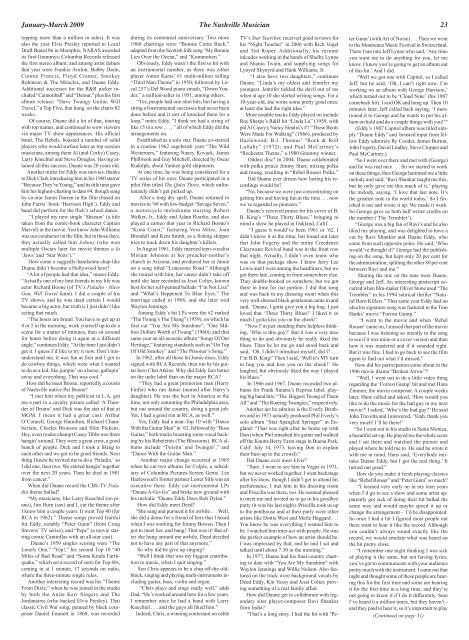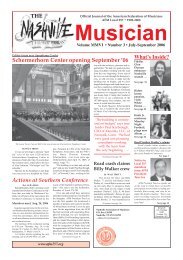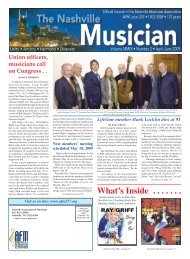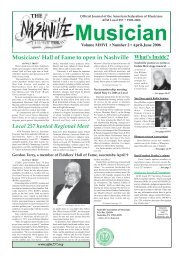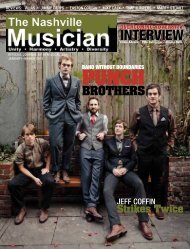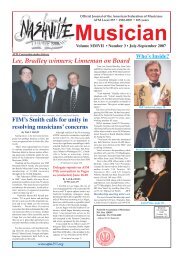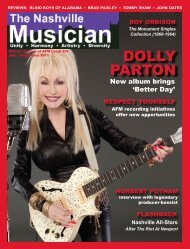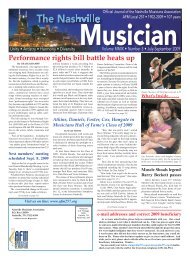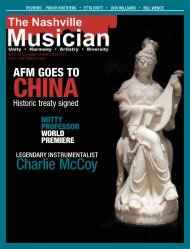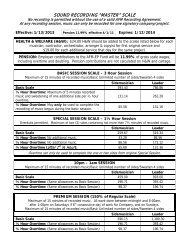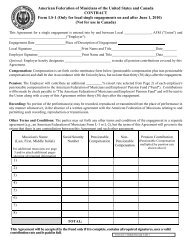Musicians Jan - 01 - Nashville Musicians Association
Musicians Jan - 01 - Nashville Musicians Association
Musicians Jan - 01 - Nashville Musicians Association
Create successful ePaper yourself
Turn your PDF publications into a flip-book with our unique Google optimized e-Paper software.
<strong>Jan</strong>uary-March 2009 The <strong>Nashville</strong> Musician 23<br />
topping more than a million in sales). It was<br />
also the year Elvis Presley reported to Local<br />
Draft Board 86 in Memphis; NARAS awarded<br />
its first Grammys; Columbia Records released<br />
the first stereo album; and among artist debuts<br />
that year were Frankie Avalon, Bobby Darin,<br />
Connie Francis, Floyd Cramer, Smokey<br />
Robinson & The Miracles, and Duane Eddy.<br />
Additional successes for the R&R picker included<br />
“Cannonball” and “Detour,” plus his first<br />
album release: “Have Twangy Guitar, Will<br />
Travel,” a Top Five, that hung on the charts 82<br />
weeks.<br />
Of course, Duane did a lot of that, touring<br />
with top names, and continued to wow viewers<br />
via major TV show appearances. His official<br />
band, The Rebels, boasted a number of solid<br />
players who would surface later as top session<br />
musicians, among them Al (and Corky) Casey,<br />
Larry Knechtel and Steve Douglas. Having attained<br />
all this success, Duane was 20 years old.<br />
Another outlet for Eddy was movies, thanks<br />
to Dick Clark introducing him in his 1960 starrer<br />
“Because They’re Young,” and its title tune gave<br />
him his highest-charting to date #4, though sung<br />
by co-star James Darren in the film (based on<br />
John Farris’ book ‘Harrison High’). Eddy and<br />
band did perform for the flick’s school dance.<br />
“I played my new single ‘Shazam’ (a title<br />
taken from the comic-book character Captain<br />
Marvel) in the movie. You know John Williams<br />
was our conductor on the film, but in those days,<br />
they actually called him Johnny (who won<br />
multiple Oscars later for movie themes a la<br />
‘Jaws’ and ‘Star Wars’).”<br />
How come a ruggedly-handsome chap like<br />
Duane didn’t become a Hollywood hero?<br />
“A lot of people had that idea,” muses Eddy.<br />
“Actually one of my best friends in my life was<br />
actor Richard Boone (of TV’s Paladin - Have<br />
Gun, Will Travel fame). I did a couple of his<br />
TV shows, and he was dead certain I would<br />
became a big actor, but truth is I just didn’t like<br />
acting that much.<br />
“The hours are brutal. You have to get up at<br />
4 or 5 in the morning, work yourself up to do a<br />
scene for a matter of minutes, then sit around<br />
for hours before doing it again at a different<br />
angle,” continues Eddy. “At the time I just didn’t<br />
get it. I guess I’d like to try it now. Don’t misunderstand<br />
me, it was fun at first and I got to<br />
do cowboy things, which were what I wanted<br />
to do as a kid, like jumpin’ on a horse, gallopin’<br />
away and everything. That was cool.”<br />
How did he meet Boone, reportedly a cousin<br />
of <strong>Nashville</strong> native Pat Boone?<br />
“I met him when my publicist in L.A. got<br />
me a part in a cavalry picture called ‘A Thunder<br />
of Drums’ and Dick was the star of that at<br />
MGM. I mean it had a great cast: Arthur<br />
O’Connell, George Hamilton, Richard Chamberlain,<br />
Charles Bronson and Slim Pickens.<br />
Hey, even (rodeo champ) Casey Tibbs was there<br />
hangin’ around. They were a great crew, a good<br />
bunch of people. Dick and I took a liking to<br />
each other and we got to be good friends. Next<br />
thing I knew he invited me to do a ‘Paladin,’ so<br />
I did one, then two. We started hangin’ together<br />
over the next 20 years. Then he died in 1981<br />
from cancer.”<br />
When did Duane record the CBS-TV Paladin<br />
theme ballad?<br />
“My musicians, like Larry Knechtel (on piano),<br />
Jim Horn (sax) and I, cut the theme after<br />
I knew him a couple years. It went Top 40 (for<br />
RCA in 1962).” Theme songs proved fruitful<br />
for Eddy, notably “Peter Gunn” (from Craig<br />
Stevens’ TV series), and “Pepe” (a movie starring<br />
comic Cantinflas with an all-star cast).<br />
Duane’s 1959 singles scoring were “The<br />
Lonely One,” “Yep!,” his second Top 10 “40<br />
Miles of Bad Road” and “Some Kinda Earthquake,”<br />
which set a record of sorts for Top 40s,<br />
coming in at 1 minute, 17 seconds on radio,<br />
where the three-minute single rules.<br />
Another interesting record was his “Theme<br />
From Dixie,” when he was joined in the studio<br />
by both the Anita Kerr Singers and The<br />
Jordanaires (who backed Elvis Presley). That<br />
classic Civil War song, penned by black composer<br />
Daniel Emmett in 1860, was recorded<br />
during its centennial anniversary. Two more<br />
1960 chartings were “Bonnie Came Back,”<br />
adapted from the Scottish folk song “My Bonnie<br />
Lies Over the Ocean,” and “Kommotion.”<br />
Obviously, Eddy wasn’t the first to hit with<br />
an instrumental number, as there was zither<br />
player Anton Karas’ #1 multi-million selling<br />
“Third Man Theme” in 1950; followed by Local<br />
257’s Del Wood piano smash, “Down Yonder,”<br />
a million-seller in 1951, among others.<br />
“Yes, people had one-shot hits, but having a<br />
string of instrumental successes had never been<br />
done before and it sort of knocked them for a<br />
loop,” notes Eddy. “I think we had a string of<br />
like 15 in a row . . . , ” all of which Eddy did the<br />
arrangements on.<br />
Established as a solo star, Duane co-starred<br />
in a routine 1962 sagebrush yarn “The Wild<br />
Westerners,” featuring Nancy Kovack, James<br />
Philbrook and Guy Mitchell, directed by Oscar<br />
Rudolph, about Yankee gold shipments.<br />
At one time, he was being considered for a<br />
TV series of his own: Duane participated in a<br />
pilot film titled The Quiet Three, which unfortunately<br />
didn’t get picked up.<br />
After a long dry spell, Duane returned to<br />
movies in ’68 with low-budget “Savage Seven,”<br />
a motorcycle melodrama starring Robert<br />
Walker, Jr., Eddy and Adam Roarke; and also<br />
played a cameo that year in Richard Boone’s<br />
“Kona Coast,” featuring Vera Miles, Joan<br />
Blondell and Kent Smith, as a fishing skipper<br />
tries to track down his daughter’s killers.<br />
In August 1961, Eddy married teen-vocalist<br />
Miriam Johnson at her preacher-mother’s<br />
church in Arizona, and produced her at Jamie<br />
on a song titled “Lonesome Road.” Although<br />
she toured with him, her career didn’t take off<br />
until she later recorded as Jessi Colter, known<br />
best for her self-penned ballads “I’m Not Lisa”<br />
and “What’s Happened To Blue Eyes.” The<br />
marriage ended in 1968, and she later wed<br />
Waylon Jennings.<br />
Among Eddy’s hit LPs were the #2 ranked<br />
“The Twang’s The Thang” (1959), on which he<br />
first cut “You Are My Sunshine”; “One Million<br />
Dollars Worth of Twang” (1960); and that<br />
same year an all-acoustic album “Songs Of Our<br />
Heritage,” featuring standards such as “On Top<br />
Of Old Smokey” and “The Prisoner’s Song.”<br />
In 1962, after all those hit Jamie discs, Eddy<br />
signed with RCA Records, then run by his guitar<br />
hero Chet Atkins. Why did Eddy fare better<br />
on the indie label than on the major RCA?<br />
“They had a great promotion man (Harry<br />
Finfer) who ran Jamie (named after Harry’s<br />
daughter). He was the best in America at the<br />
time, not only saturating the Philadelphia area,<br />
but out around the country, doing a great job.<br />
Yet, I had a good run at RCA, as well.”<br />
Yes, Eddy had a near-Top 10 with “Dance<br />
With the Guitar Man” in ’62, followed by “Boss<br />
Guitar,” both tracks boasting some vocal backing<br />
by his Rebelettes (The Blossoms). RCA albums<br />
include “Twistin’ and Twangin’,” and<br />
“Dance With the Guitar Man.”<br />
Another major change occurred in 1965<br />
when he cut two albums for Colpix, a subsidiary<br />
of Columbia Pictures-Screen Gems. Lee<br />
Hazlewood’s former partner Lester Sills was an<br />
executive there. Eddy cut instrumental LPs<br />
“Duane A-Go-Go” and broke new ground with<br />
his melodic “Duane Eddy Does Bob Dylan.”<br />
How did Eddy meet Deed?<br />
“She sang and pursued it for awhile . . . Well,<br />
she did a demo for a friend of hers that I heard<br />
when I was working for Jimmy Bowen. Then I<br />
got to meet her, and bang! That was it! But after<br />
she hung around me awhile, Deed decided<br />
not to have any part of that anymore.”<br />
So why did he give up singing?<br />
“Well I think that was my biggest contribution<br />
to music, when I quit singing.”<br />
Son Chris appears to be a chip off-the-oldblock,<br />
singing and playing multi-instruments including<br />
guitar, bass, violin and organ.<br />
“Chris plays and sings really well,” adds<br />
Dad. “He’s worked around here for a few years.<br />
I remember once he had a band with Larry<br />
Knechtel . . . and the guys all liked him.”<br />
Indeed, Chris, a winning contestant on cable<br />
TV’s Star Searcher, received good reviews for<br />
his “Night Toucher” in 2006 with Rich Vogel<br />
and Ted Roper. Additionally, his resume<br />
inlcudes working in the bands of Shelby Lynne<br />
and Shania Twain, and supplying songs for<br />
Lynyrd Skynyrd and Hank Williams, Jr.<br />
“I also have two daughters,” continues<br />
Duane. “Linda’s my oldest and Jennifer my<br />
youngest. Jennifer tickled the devil out of me<br />
when at age 10 she started writing songs. For a<br />
10-year-old, she wrote some pretty good ones;<br />
at least she had the right idea.”<br />
More notable tracks Eddy played on include<br />
Ray Sharpe’s R&B hit “Linda Lu” (1959, with<br />
pal Al Casey); Nancy Sinatra’s #1 “These Boots<br />
Were Made For Walking” (1966), produced by<br />
Hazlewood; B.J. Thomas’ “Rock & Roll<br />
Lullaby” (1972); and Paul McCartney’s<br />
“Rockestra Theme,” a 1980 Grammy winner.<br />
Oddest disc? In 2004, Duane collaborated<br />
with polka prince Jimmy Sturr, mixing polka<br />
and twang, resulting in “Rebel Rouser Polka.”<br />
Did Duane ever dream how lasting his recordings<br />
would be?<br />
“No, because we were just concentrating on<br />
getting hits and having fun at the time . . . now<br />
we’re regarded as pioneers.”<br />
Duane’s received praise for his cover of B.<br />
B. King’s “Three Thirty Blues,” bringing to<br />
mind a show he played in Oakland, Calif.<br />
“I guess it would’ve been 1961 or ’62. I<br />
didn’t know it at the time, but found out later<br />
that John Fogerty and the entire Creedence<br />
Clearwater Revival band was in the front row<br />
that night. Actually, I didn’t even know who<br />
was on that package show. I knew Jerry Lee<br />
Lewis and I were among the headliners, but we<br />
got there late, coming in from somewhere else.<br />
They double-booked us somehow, but we got<br />
there in time for our portion. I did that song<br />
and was back in my dressing room when this<br />
very well-dressed black gentleman came in and<br />
said, ‘Duane, I gotta give you a big hug. I just<br />
loved that ‘Three Thirty Blues!’ I liked it so<br />
much I gotta kiss you on the cheek!’<br />
“Now I’m just standing there helpless thinking,<br />
‘Who is this guy?’ But it was a very nice<br />
thing to do and obviously he really liked the<br />
blues. Then he let me go and stood back and<br />
said, ‘Oh, I didn’t introduce myself, did I? . . .<br />
I’m B.B. King!’ Then I said, ‘Well it’s MY turn<br />
to hug you and kiss you on the cheek!’ He<br />
laughed, but obviously liked the way I played<br />
his blues.”<br />
In 1966 and 1967, Duane recorded two albums<br />
for Frank Sinatra’s Reprise label, playing<br />
big band hits: “The Biggest Twang of Them<br />
All” and “The Roaring Twangies,” respectively.<br />
Another act he admires is the Everly Brothers<br />
and in 1973 actually produced Phil Everly’s<br />
solo album “Star Spangled Springer” in England:<br />
“That was right after he broke up with<br />
Don (when Phil smashed his guitar and walked<br />
off the Knotts Berry Farm stage in Buena Park,<br />
Calif. July 14, 1973, leaving Don to explain<br />
their bust-up to the crowd).”<br />
Did Duane ever meet Elvis?<br />
“Sure. I went to see him in Vegas in 1971,<br />
but we never worked together. I went backstage<br />
after his show, though I didn’t get to attend his<br />
performance. I met him in his dressing room<br />
and Priscilla was there, too. He seemed pleased<br />
to meet me and invited us to go to his goodbye<br />
party (it was his last night). Priscilla took us up<br />
to the penthouse and at their party were other<br />
artists like Dottie West and Merle Haggard . . .<br />
You know he was everything I wanted him to<br />
be. I watched him inter-act with people. He was<br />
the perfect example of how an artist should be.<br />
I was impressed by that, and he and I sat and<br />
talked until about 7:30 in the morning.”<br />
In 1977, Duane had his final country charting<br />
to date with “You Are My Sunshine” with<br />
Waylon Jennings and Willie Nelson. Also featured<br />
on the track were background vocals by<br />
Deed Eddy, Kin Vassy and Jessi Colter, proving<br />
something of a real family affair.<br />
How did Duane get to collaborate with legendary<br />
sitar player-composer Ravi Shankar<br />
from India?<br />
“That’s a long story. I had the hit with ‘Pe-<br />
ter Gunn’ (with Art of Noise) . . . Then we went<br />
to the Montreaux Music Festival in Switzerland.<br />
There I ran into Jeff Lynne who said, ‘Any time<br />
you want me to do anything for you, let me<br />
know. I know you’re going to get an album out<br />
of this hit.’ And I did.<br />
“Well we got one with Capitol, so I called<br />
Jeff, but he said, ‘Oh, I can’t right now, I’m<br />
working on an album with George Harrison,’<br />
which turned out to be ‘Cloud Nine’ (his 1987<br />
comeback hit). I said OK and hung up. Then 10<br />
minutes later, Jeff called back saying, ‘I mentioned<br />
it to George and he wants to put his album<br />
on hold and do a couple things with you!’”<br />
(Eddy’s 1987 Capitol album was titled simply<br />
“Duane Eddy” and boasted input from fellow<br />
Eddy admirers Ry Cooder, James Burton,<br />
John Fogerty, David Lindley, Steve Cropper and<br />
Paul McCartney.)<br />
“So I went over there and met with (George)<br />
and he was real nice . . . So we started to work<br />
on these things, then George hummed me a little<br />
melody and said, ‘Ravi Shankar taught me this,<br />
but he only gave me this much of it,’ playing<br />
the melody, saying, ‘I love that last note. It’s<br />
the greatest note in the world today.’ So I finished<br />
it out and wrote it up. We made it work.<br />
So George gave us both half writer credits on<br />
the number (‘The Trembler’).<br />
“George was a big fan of Ravi’s and he also<br />
liked my playing, and was delighted to have a<br />
cut by Ravi Shankar and Duane Eddy, who<br />
came from such opposite poles. He said, ‘Who<br />
would’ve thought it?’ George had the publishing<br />
on the song, but kept only 20 per cent for<br />
the administration, splitting the other 80 per cent<br />
between Ravi and me.”<br />
Sharing the mic on the tune were Duane,<br />
George and Jeff. An interesting postscript occurred<br />
when film-maker Oliver Stone used “The<br />
Trembler” in his 1994 satirical thriller “Natural<br />
Born Killers.” That same year Eddy had no<br />
idea his signature song was featured in the Tom<br />
Hanks’ movie “Forrest Gump.”<br />
“I went to the movie and when ‘Rebel<br />
Rouser’ came on, I missed that part of the movie<br />
because I was listening so intently to the song<br />
to see if it was mine or a cover version and then<br />
how it was mastered and if it sounded right.<br />
But it was fine. I had to go back to see the film<br />
again to find out what I’d missed.”<br />
How did his participation come about in the<br />
1996 movie drama “Broken Arrow”?<br />
“Well, I went out to do a little video thing<br />
regarding the ‘Forrest Gump’ bit and met Hans<br />
Zimmer, the movie composer. A couple weeks<br />
later, Hans called and asked, ‘How would you<br />
like to do the music for the bad guy in my next<br />
movie?’ I asked, ‘Who’s the bad guy?’ He said<br />
John Travolta and I answered, ‘Yeah, thank you<br />
very much! I’ll be there!’<br />
“So I went out to his studio in Santa Monica,<br />
a beautiful set-up. He played me the whole score<br />
and I sat there and watched the picture and<br />
played where he told me to. He said he wrote it<br />
with me in mind. Hans said, ‘Everybody imitates<br />
Duane Eddy, but I got the real thing.’ It<br />
turned out good.”<br />
How do you make it fresh playing classics<br />
like “Rebel Rouser” and “Peter Gunn” so much?<br />
“I learned very early on in my teen years<br />
when I’d go to see a show and some artist apparently<br />
got sick of doing their hit ballad the<br />
same way and would maybe speed it up or<br />
change the arrangement - I’d be disappointed.<br />
So once I had a hit I figured most people out<br />
there want to hear it like the record. Although<br />
you couldn’t always sound exactly like the<br />
record, we would emulate what was heard on<br />
the hit pretty close.<br />
“I remember one night thinking I was sick<br />
of playing it the same, but not having lyrics,<br />
you’ve got to communicate with your audience<br />
pretty much with the instrument. I came out that<br />
night and thought some of these people are hearing<br />
this for the first time and some are hearing<br />
it for the first time in a long time, and they’re<br />
not going to know it if I do it differently. Sure<br />
I’ve heard it a million times, but they haven’t -<br />
and they paid to hear it, so it’s important to play<br />
(Continued on page 31)


